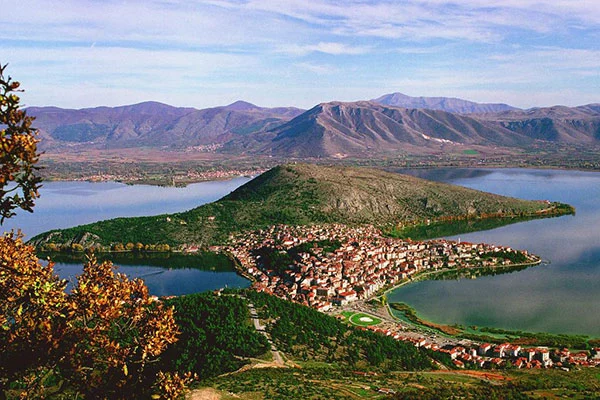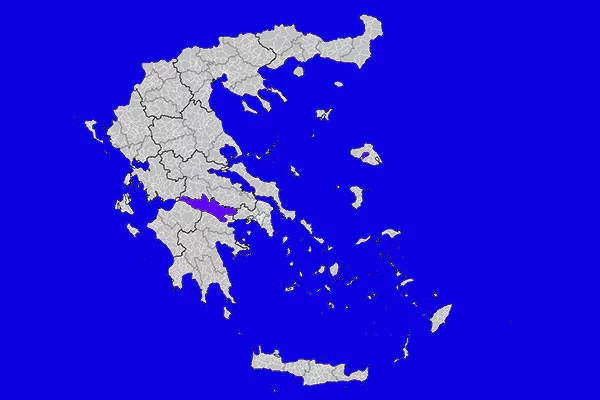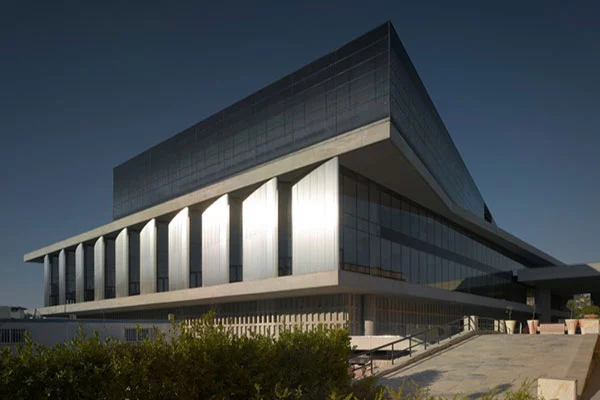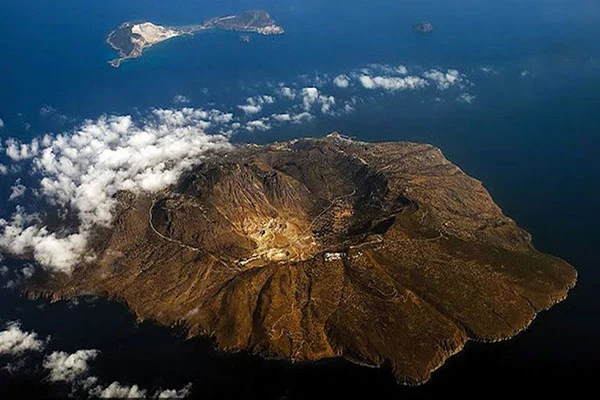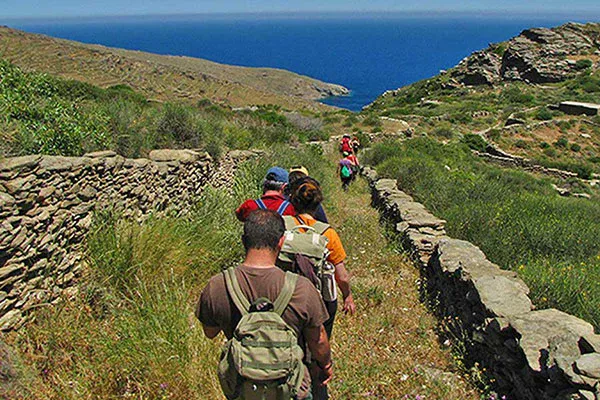
Mystras
In late 1248, William II of Villehardouin, ruler of the Frankish Principality of Achaea, captured Monemvasia, the last remaining Byzantine outpost on the Morea. This success was soon followed by the submission of the restive Tsakones on Mount Parnon, the Slavic Melingoi tribe of Mount Taygetos, and the inhabitants of the Mani peninsula, thereby extending his sway over all of Laconia and completing the conquest of the peninsula, which had begun in 1205, in the aftermath of the Fourth Crusade. Laconia was incorporated into the princely domain, and the young prince passed the winter of 1248–49 there, touring the country and selecting sites for new fortifications such as Grand Magne and Leuktron; finally, near his residence of Lacedaemon (ancient Sparta), on a spur of Mount Taygetos, he built the fortress that came to be known as Mystras.
In September 1259, William of Villehardouin was defeated and captured, along with many of his nobles, at the Battle of Pelagonia, by the forces of the Nicaean emperor Michael VIII Palaiologos. Two years later, the Nicaeans recaptured Constantinople, putting an end to the Latin Empire and restoring the Byzantine Empire. At this point, the emperor concluded an agreement with the captive prince: William and his men would be set free in exchange for an oath of fealty, and for the cession of Monemvasia, Grand Magne, and Mystras. The handover was effected in 1262, and henceforth Mystras was the seat of the governor of the Byzantine territories in the Morea. Initially this governor (kephale) was changed every year, but after 1308 they started being appointed for longer terms. Almost immediately on his return to the Morea, William of Villehardouin renounced his oath to the emperor, and warfare broke out between Byzantines and Franks. The first Byzantine attempts to subdue the Principality of Achaea were beaten back in the battles of Prinitsa and Makryplagi, but the Byzantines were firmly ensconced in Laconia. Warfare became endemic, and the Byzantines slowly pushed the Franks back. The insecurity engendered by the raids and counter-raids caused the inhabitants of Lacedaemon to abandon their exposed city and settle at Mystras, in a new town built under the shadow of the fortress.
From 1348 until its surrender to the Ottoman Turks on 31 May 1460, Mystras was the residence of a Despot who ruled over the Byzantine Morea, known as the "Despotate of the Morea". This was the city's golden age; according to the Oxford Dictionary of Byzantium, Mystras "witnessed a remarkable cultural renaissance, including the teaching of Plethon, and attracted artists and architects of the highest quality".
The frescos in the Perivleptos Monastery Church, dating between 1348 and 1380, are a very rare surviving late Byzantine cycle, crucial for the understanding of Byzantine art.
Mystras was also the last centre of Byzantine scholarship; the Neoplatonist philosopher George Gemistos Plethon lived there until his death in 1452. He and other scholars based in Mystras influenced the Italian Renaissance, especially after he accompanied the emperor John VIII Palaiologos to Florence in 1439.
The last Byzantine emperor, Constantine XI Palaiologos, was despot at Mystras before he came to the throne. Demetrius Palaeologus the last despot of Morea, surrendered the city to the Ottoman emperor Mehmed II in 1460. As Mezistre, it was the seat of a Turkish sanjak. The Venetians occupied it from 1687 to 1715, but otherwise the Ottomans held it until 1821 and the beginning of the Greek War of Independence. It was abandoned under King Otto for the newly rebuilt town of Sparta.
In 1989 the ruins, including the fortress, palace, churches, and monasteries, were named a UNESCO World Heritage Site.
Mystras, as the centre of Byzantine power, quickly attracted inhabitants and institutions; the bishopric was transferred there from Sparta, with its cathedral, the Metropolis or church of Agios Demetrios, built after 1264. Many monasteries were founded there, including those of the Vrontochion and the monastery of Christos Zoodotes (Christ the Giver of Life). Under the Despots, Mystras reached its zenith with the building of churches, outstanding examples of Late Byzantine church architecture, such as Agii Theodori (1290-1295), the Odigitria (c. 1310), the Agia Sophia (1350-1365), the Perivleptos (3rd quarter of the 14th century), the Evangelistria (late 14th – early 15th century) and the Pantanassa (c. 1430). The city was a major piece on the political chessboard of the time and was developed and beautified as befitted its role as a centre of power and culture. The city’s complex history is clearly evident in its fortifications, palaces, churches, convents, houses, streets and public squares.
Mystras’ distinct architecture is influenced by the so-called “Helladic” school of Byzantine architecture as well as the architecture of Constantinople. The painting of churches reflects the quality and the eclecticism of the art of Constantinople. Elements of Romanesque and Gothic art are also present as a result of the city’s wide range of contacts during the 14th and 15th centuries. The beauty of its churches, which during the Palaeologan Renaissance were covered with magnificent frescoes, the renown of its libraries and the glory of its writers, including the philosopher Georgios Gemistos Plethon and his pupil, the intellectual Bessarion, later cardinal of the Roman Catholic church, who brought neo-platonic humanism to Italy, gave substance thereafter to the legend of the Wonder of the Morea. Mystras is therefore a truly outstanding example of late Byzantine culture which influenced the rest of the Mediterranean world and beyond.
Site Monuments:
1. The Acropolis and the Fortification of the Castle
The Frankish castle with the battlements and towers was founded by William II de Villeharduin and was later reinforced by the Greeks and the Turks. The two strongly fortified circuit walls were strengthened by tall, rectangular towers, dated to the Late Byzantine period.
2. The Cathedral of Agios Demetrios
It belongs to a mixed architectural type: it is a three-aisled basilica on the ground floor with a narthex and a bell tower (dated to the second half of the 13th century), and a cross-in-square church on the upper floor (added in the first half of the 15th century). The interior is decorated with wall paintings representing many different styles, dated to the period between 1270/80 and the first quarter of the 14th century. The wall paintings of the dome date to the 15th century.
3. The Church of Agii Theodori
It was built between 1290 and 1295 by the monks Daniel and Pachomios. It is of the octagonal type, with lateral chapels, and is decorated with wall paintings dating from the end of the 13th century.
4. The Church of Our Lady Odigitria (the Leader of the Way)
It was built in 1310 by abbot Pachomios. It belongs to the mixed architectural type with a narthex and lateral chapels and is decorated with excellent wall paintings, dated to 1312-1322, some of which are connected to the Constantinopolitan art.
5. The Church of Agia Sofia (Holy Wisdom)
Domed, cross-in-square, two-column church, built in the middle of the 14th century. It has side chapels and a bell-tower. Remarkable wall paintings are preserved in the sanctuary and the chapels.
6. The Monastery of Our Lady Perivleptos
The catholicon (main church) is a domed, two-column, cross-in-square church with chapels. Beside it stands the Tower-Refectory. The church is decorated with wall paintings of exceptional artistic quality, made by various artists of the third quarter of the 14th century.
7. The Church of Our Lady Evangelistria (of the Annunciation)
Domed, cross-in-square, two-column church decorated with wall paintings of the beginning of the 15th century.
8. The Monastery of Our Lady Pantanassa (the Queen of all)
The catholicon belongs to the mixed architectural type and has exterior porticoes and a bell tower. Fine wall paintings dated to ca. 1430 are preserved on the upper floor and in the sanctuary, while the wall paintings on the ground floor date from the 18th century.
9. The Palaces of the Mystras Despots (Kandakouzini and Paleologi)
Large building complex, L-shaped in plan. It contains many buildings of different functions, erected in different phases between the 13th and the 15th centuries.
10. The Urban Buildings
The most interesting of the urban buildings erected on the hill are the Palataki (Small Palace), the House of Frangopoulos and the House of Laskaris.


